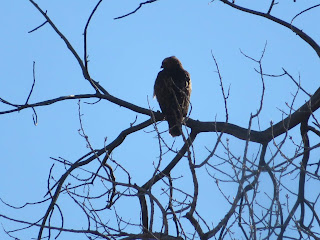Water is a big deal here in New Mexico. All the more so because water just won't sit in big holes in the ground like it should. This happens normally both north and south of our location, but the desert just doesn't co-operate with producing the volumes of water we require. However, Corrales is lucky in that we have irrigation from the river, and the lions share of the water that is available. In this picture you can see one of the problems that can develop. The caliche is a band of white in the soil where salts are building up from the dual action of evaporation of water and a buildup of salts left behind. This causes poor drainage and plant damage and is solved by using excess water to rinse it out, which does not happen with private electric pump irrigation systems. The traditional gravity irrigation and associated acequias is gradually losing favor in Corrales, especially as it requires a community to be involved. MRGCD will never be able to manage this resource without community input.
Two years of drought has left a fragile soil, that soil is literally pounded into dust by heavy use from pedestrians. Here you can see tracks of vehicles, people, horses, and a few foraging birds.
The song sparrow requires heavy cover to live happily. Right now, a lot of them are foraging and singing each morning. Usually by 11am the various small flocks have virtually disappeared from view. They are drawn into the open by the abundant laying insects out right now.
This female bird looks nothing like the flashy male, but is definitely in the right habitat. These birds live and nest in thick stands of cattails, and are pretty common in other areas of Albuquerque. The males need large stands of dense reeds though. They are often seen in the South Valley.
Once I started to understand the ducks, the world made a lot more sense. The beaks vary so much from the massive shovellers, to the bluebills, the teals, and the pervasive mallards, like this one. These guys are right now busy shoveling through the mud and churning up the sediment to run further downstream. In their wake they usually leave chocolate milk colored water trail that persists. Mallards seem to work well in large groups, and are the most fearless. They seem to be pretty well adapted to human presence.
We have many birds that travel along the Rio grande flyway. I have noticed that when we have a large cold front north of us, we tend to see the black ravens get replaced by white gulls on the trash sites outside of town.
It can be very annoying to have a beautiful bird that just won't look in the right direction. Still, I like these kinds of common shots because they tell you so much more about the wilds that a perfectly staged once in a lifetime shot taken by a professional that no-one else could ever take. I used to never see these blue-birds, but at least for now, they are all over the fields and larger lawns.
Bird silhouettes have a very mellowing kind of feel, but that very comforting feeling could also be coming from the deep field of azure behind them. This red tailed hawk is just waiting patiently for something edible to happen. I've never seen them eat a duck but I still think that's what they are looking at, even though they are far more well known for hunting rabbits.
The herons had vanished for a couple of weeks, but they have returned. Interestingly they are not using the same roost sites they used to. So, maybe these are different birds?









So interesting. When I saw the first picture of the heron (just the head and shoulders), I knew it was a heron-type bird. I'm from Nebraska and became an amateur bird watcher when we lived in a cabin on the Big Blue River near Milford, Nebraska for a few years in the 1980s. Then I moved to New Jersey near the shore - a whole different type of birds there. Here, sadly, I seem too busy to watch birds, but I do have some nice bird pictures - a roadrunner in my yard and a small brown and yellow bird with a tuft on his head who used to stay under my patio cover each night. I have been to the Bosque del Apache and got some great shots there of the cranes too. Such fun.
ReplyDeleteThe sandhill cranes here are all around in the bosque too, but they stay near to where people feed them corn. They are scheduled to vanish in the next month or so when the hummingbirds and tyrant flycatchers move in (very agressive nest protectors).
ReplyDeleteHopefully by then I can move on to the cold bloods. Birds are okay, but they kind of overshadow all the other stuff around us!
Of course, with the ditches not filling with water until April this years, things might be different!